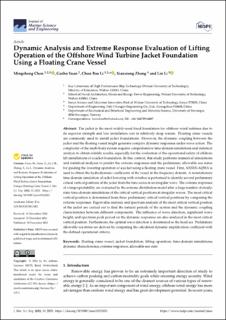| dc.contributor.author | Chen, Mingsheng | |
| dc.contributor.author | Yuan, Guibo | |
| dc.contributor.author | Li, Chun Bao | |
| dc.contributor.author | Zhang, Xianxiong | |
| dc.contributor.author | Li, Lin | |
| dc.date.accessioned | 2023-01-09T07:24:22Z | |
| dc.date.available | 2023-01-09T07:24:22Z | |
| dc.date.created | 2023-01-05T15:19:08Z | |
| dc.date.issued | 2022 | |
| dc.identifier.citation | Chen, M., Yuan, G., Li, C. B., Zhang, X., & Li, L. (2022). Dynamic analysis and extreme response evaluation of lifting operation of the offshore wind turbine jacket foundation using a floating crane vessel. Journal of Marine Science and Engineering, 10(12), 2023. | en_US |
| dc.identifier.issn | 2077-1312 | |
| dc.identifier.uri | https://hdl.handle.net/11250/3041721 | |
| dc.description.abstract | The jacket is the most widely-used fixed foundation for offshore wind turbines due to its superior strength and low installation cost in relatively deep waters. Floating crane vessels are commonly used to install jacket foundations. However, the dynamic coupling between the jacket and the floating vessel might generate complex dynamic responses under wave action. The complexity of the multi-body system requires comprehensive time-domain simulations and statistical analysis to obtain reliable results, especially for the evaluation of the operational safety of offshore lift installations of a jacket foundation. In this context, this study performs numerical simulations and statistical analyses to predict the extreme responses and the preliminary allowable sea states for guiding the lowering operation of a jacket using a floating crane vessel. First, ANSYS-AQWA is used to obtain the hydrodynamic coefficients of the vessel in the frequency domain. A nonstationary time-domain simulation of jacket lowering with winches is performed to identify several preliminary critical vertical positions of the jacket from the time series in an irregular wave. The extreme responses of a target probability are evaluated by the extreme distribution model after a large number of steady-state time-domain simulations of the critical vertical positions in irregular waves. The most critical vertical position is determined from three preliminary critical vertical positions by comparing the extreme responses. Eigenvalue analysis and spectrum analysis of the most critical vertical position of the jacket are carried out to find the natural periods of the system and the dynamic coupling characteristics between different components. The influence of wave direction, significant wave height, and spectrum peak period on the dynamic responses are also analyzed in the most critical vertical position. Furthermore, the optimal wave direction is determined as the head sea. Preliminary allowable sea states are derived by comparing the calculated dynamic amplification coefficient with the defined operational criteria. | en_US |
| dc.language.iso | eng | en_US |
| dc.publisher | MDPI | en_US |
| dc.rights | Navngivelse 4.0 Internasjonal | * |
| dc.rights.uri | http://creativecommons.org/licenses/by/4.0/deed.no | * |
| dc.title | Dynamic Analysis and Extreme Response Evaluation of Lifting Operation of the Offshore Wind Turbine Jacket Foundation Using a Floating Crane Vessel | en_US |
| dc.title.alternative | Dynamic Analysis and Extreme Response Evaluation of Lifting Operation of the Offshore Wind Turbine Jacket Foundation Using a Floating Crane Vessel | en_US |
| dc.type | Peer reviewed | en_US |
| dc.type | Journal article | en_US |
| dc.description.version | publishedVersion | en_US |
| dc.rights.holder | The author | en_US |
| dc.subject.nsi | VDP::Teknologi: 500 | en_US |
| dc.source.volume | 10 | en_US |
| dc.source.journal | Journal of Marine Science and Engineering | en_US |
| dc.source.issue | 12 | en_US |
| dc.identifier.doi | 10.3390/jmse10122023 | |
| dc.identifier.cristin | 2101478 | |
| cristin.ispublished | true | |
| cristin.fulltext | original | |
| cristin.qualitycode | 1 | |

